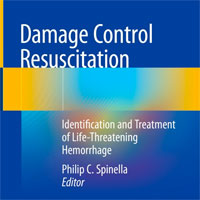Tag: hemorrhage
Fever Management with or without a Temperature Control Device After OHCA and Resuscitation
the TEMP‐CARE trial will advance our understanding of post‐cardiac arrest care fever management strategies. With a large sample size and a broad patient population, the results of this trial will inform clinical practice... read more
Wireless Wearable Doppler Ultrasound: Monitoring Trauma Patients
This study demonstrated the feasibility of placing the wireless, wearable Doppler ultrasound on severely injured trauma patients admitted to the trauma bay of a busy level 1 trauma center. The device reliably captured... read more
Early Initiated Noradrenaline vs. Fluid Therapy for Hypotension and Shock
The VASOSHOCK trial is a pragmatic, multi-center, superiority, randomized controlled trial investigating early initiation of peripheral noradrenaline in hypotension and shock, investigating the impact of this treatment on... read more
Ventilation Practices in ABI Patients and Association with Outcomes
Current mechanical ventilation practices for patients with acute brain injury (ABI) are poorly defined. This study aimed to describe ventilator settings/parameters used in intensive care units (ICUs) and evaluate their association... read more
Septic Distributive Shock: Resuscitative Endovascular Balloon Occlusion of the Aorta
Massive distributive shock can lead to total collapse of the cardiopulmonary system with a subsequent need for CPR. Partial REBOA may be a viable resuscitation adjunct in such cases to restore hemodynamics and increase coronary... read more
Provocative Angiography Safety and Efficacy for Gastrointestinal Hemorrhage Localization and Treatment
This study demonstrated that provocative angiography was safe and effective for localization of intermittent or occult gastrointestinal bleeding. Overall, provocative angiography had a positivity rate of 14/40 (35 %) in this... read more
Factors Influencing the Mortality of Patients with Subarachnoid Hemorrhage in the ICU
Spontaneous subarachnoid hemorrhage (SAH) is a prevalent condition for those between the ages of 50 and 60 years, with a high mortality rate in severe cases. The findings of this study indicate that a history of loss... read more
Late Hemorrhagic Complication and Unilateral Neck Edema Related to Cannulation in VV-ECMO
This is a rare case of delayed acute unilateral neck edema that developed during veno-venous extracorporeal membrane oxygenation (VV-ECMO). This case underscores the importance of considering a wide range of differential... read more
Vital Signs and Serum Biomarkers Model Outperforms Shock Index in HCI Prediction
In this study of surgical ICU patients with concern for ongoing bleeding, a prediction model using serial VS and biomarkers outperformed the SI and may help identify those requiring hemorrhage control interventions (HCI). This... read more
Venous/arterial Thromboembolism – Rare Side Effect Of Prothrombin Complex Concentrate
Venous/arterial thrombosis and pulmonary thrombosis accounts for very rare side effects of prothrombin complex concentrate and should be taken into account while administration. 68-year-old male with history of stroke,... read more
Risk Factors for Traumatic Intracranial Hemorrhage in Mild TBI Patients
The findings from this study provide additional context to risk factors currently in use as components in guidelines for the management of mild traumatic brain injury (mTBI) in the ED setting, contrasting high risk predictors... read more
Antithrombin III Levels and Outcomes Among Patients With Trauma
In this cohort study of trauma patients, antithrombin III deficiency was associated with greater severity of illness and worse hospital outcomes. Specifically, antithrombin III deficiency was associated with fewer ventilator-free... read more
Noninvasive Monitoring of Changes in Cerebral Hemodynamics During Prolonged Field Care for Hemorrhagic Shock and Hypoxia-Induced Injuries With Portable Diffuse Optical Sensors
There is a consistency in blood flow measures in both injury mechanisms (hemorrhagic shock and hypoxia), which is significant as the new prototype system provides similar measures and trends for each brain injury type, suggesting... read more
Endothelial Activation and Microcirculatory Disorders in Sepsis and Critical Illness
The endothelium is one of the largest organs in the human body and lines the blood vessels and microcirculation of all the vital organs. As such, it functions as a massive and critical surveillance system to orchestrate recognition... read more
Tailoring Antithrombotic Treatment in Patients with Acute Myocardial Infarction and Cancer
For more than two decades, dual platelet antiplatelet therapy (DAPT) has been one of the mainstays in the treatment of patients who have suffered an acute myocardial infarction (AMI) or undergoing percutaneous coronary intervention... read more
Traumatic Major Hemorrhage in a Tertiary Trauma Center
Major traumatic hemorrhage is potentially preventable with rapid hemorrhage control and improved resuscitation techniques. The time from injury to hospital, resuscitation, diagnosis, and definitive bleeding control should... read more
Damage Control Resuscitation: Identification and Treatment of Life-Threatening Hemorrhage
This book provides a comprehensive overview of damage control resuscitation (DCR), an evidence-based approach to the resuscitation of patients with severe life-threatening hemorrhage (LTH). It focuses on both civilian... read more

TXA Should be Urgently and Broadly Adopted for Brain Bleeds
Everything looked better with tranexamic acid (TXA), and none of it was statistically significant. True, in a subgroup analysis of patients who actually had a head bleed on imaging—which, gee whiz, seems like an important... read more
Artesunate Treatment in Severely Injured Patients with Traumatic Hemorrhage
In this study of critically injured trauma patients with major hemorrhage, artesunate did not improve organ dysfunction and was potentially associated with an increased VTE risk. Future studies that focus on immune responses... read more
Early Control of Elevated Blood Pressure – INTERACT3
Early control of elevated blood pressure is the most promising treatment for acute intracerebral hemorrhage. We aimed to establish whether implementing a goal-directed care bundle incorporating protocols for early intensive... read more
Disseminated Intravascular Coagulation in COVID-19 Setting
Disseminated intravascular coagulation (DIC) is an acquired syndrome that can lead to catastrophic thrombosis and hemorrhage. In DIC, an uncontrolled release of pro-inflammatory mediators activates tissue factor-dependent... read more
Traumatic Hemorrhage and Chain of Survival
Trauma is the number one cause of death among Americans between the ages of 1 and 46 years, costing more than $670 billion a year. Following death related to central nervous system injury, hemorrhage accounts for the majority... read more









